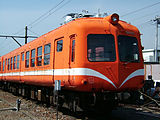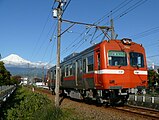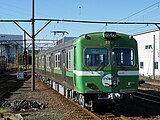Gakunan Railway Line: Difference between revisions
Cards84664 (talk | contribs) →Stations: Central, not East |
|||
| (33 intermediate revisions by 20 users not shown) | |||
| Line 1: | Line 1: | ||
{{Short description|Railway line in Shizuoka Prefecture, Japan}} |
|||
[[Image:Gakunan train at Yoshiwara Station 200511.jpg|thumb|Gakunan Railway train at Yoshiwara Station.]] |
|||
{{Infobox rail line |
|||
The {{nihongo|'''Gakunan Railway Line'''| |
|||
| box_width = |
|||
| name = Gakunan Railway Line |
|||
| color = FF4500 <!-- "orangered" --> |
|||
| logo = |
|||
| logo_width = |
|||
| image = Gakunan train at Yoshiwara Station 200511.jpg |
|||
| image_width = 300px |
|||
| caption = A Gakunan train at Yoshiwara Station, November 2011 |
|||
| type = [[Heavy rail]] |
|||
| system = |
|||
| status = |
|||
| locale = [[Shizuoka Prefecture]] |
|||
| start = {{STN|Yoshiwara}} |
|||
| end = {{STN|Gakunan-Enoo}} |
|||
| stations = 10 |
|||
| routes = |
|||
| daily_ridership = |
|||
| open = 1936 |
|||
| close = |
|||
| owner = |
|||
| operator = Gakunan Electric Train Co., Ltd. |
|||
| character = |
|||
| depot = |
|||
| stock = |
|||
| linelength = {{Convert|9.2|km|mi|abbr=on}} |
|||
| tracklength = |
|||
| tracks = |
|||
| gauge = {{track gauge|1067mm}} |
|||
| minradius = |
|||
| electrification = 1500 V DC overhead |
|||
| speed = |
|||
| elevation = |
|||
| map = {{routemap|inline=1|map = |
|||
BHFq\ABZq+l\STRq~~ ~~ ~~[[Tōkaidō Main Line]] |
|||
KBHFaq\ABZqr\STR+r~~0.0~~[[Yoshiwara Station]] |
|||
hSTR+l\hSTRq\KRZh~~ ~~ ~~[[ Tōkaidō Shinkansen]] |
|||
LSTR\\eDST~~1.8~~Hidari-Fuji Signal |
|||
\\BHF~~2.3~~[[Jatco-mae Station]] |
|||
\\BHF~~2.7~~[[Yoshiwara-honchō Station]] |
|||
\\BHF~~3.0~~[[Hon-Yoshiwara Station]] |
|||
\\eDST~~3.7~~Tajuku Signal |
|||
\\BHF~~4.4~~[[Gakunan-Harada Station]] |
|||
\\BHF~~5.4~~[[Hina Station]] |
|||
\\BHF~~6.4~~[[Gakunan-Fujioka Station]] |
|||
\\BHF~~7.3~~[[Sudo Station]] |
|||
LSTR\\BHF~~8.2~~[[Kamiya Station]] |
|||
hSTRl\hSTRq\KRZh~~ ~~ ~~Tōkaidō Shinkansen |
|||
\\KBHFe~~9.2~~[[Gakunan-Enoo Station]] |
|||
}} |
|||
| map_state = collapsed |
|||
}} |
|||
The {{nihongo|'''Gakunan Railway Line'''| |
|||
==Basic data== |
|||
*Distance: 9.2 [[Kilometre|km]] / 5.7 [[mile|mi.]] |
|||
*[[Rail gauge|Gauge]]: 1,067 [[Millimetre|mm]] / 3 [[foot (unit of length)|ft.]] 6 [[inch|in.]] |
|||
*Stations: 10 |
|||
*Double-track line: None |
|||
*Electric supply: Whole the line (1500 [[Volt|V]] [[Direct current|DC]]) |
|||
*[[Railway signalling]]: Automatic |
|||
==Stations== |
==Stations== |
||
*{{ja-stalink|Yoshiwara}} [[:ja: |
|||
*{{ja-stalink|Jatco-mae}} [[:ja:ジヤトコ |
|||
*{{ja-stalink|Yoshiwara-honchō}} [[:ja: |
|||
*{{ja-stalink|Hon-Yoshiwara}} [[:ja: |
|||
*{{ja-stalink|Gakunan-Harada}} [[:ja: |
|||
*{{ja-stalink|Hina}} [[:ja: |
|||
*{{ja-stalink|Gakunan-Fujioka}} [[:ja: |
|||
*{{ja-stalink|Sudo}} [[:ja: |
|||
*{{ja-stalink|Kamiya}} [[:ja: |
|||
*{{ja-stalink|Gakunan-Enoo}} [[:ja: |
|||
{| class="wikitable" |
|||
==See also== |
|||
|- |
|||
{{commonscat|Gakunan Railway}} |
|||
!rowspan="2"|No. |
|||
*[[List of railway companies in Japan]] |
|||
!rowspan="2"|Station |
|||
*[[List of railway lines in Japan]] |
|||
!rowspan="2"|Japanese |
|||
!colspan="2"|Distance<br>(km) |
|||
!rowspan="2"|Transfers |
|||
!rowspan="2"|Location |
|||
|- |
|||
!Between<br />stations |
|||
!Total |
|||
|- |
|||
|GD01 |
|||
| {{STN|Yoshiwara}} |
|||
| |
|||
|style="text-align:right;"|– |
|||
|style="text-align:right;"|0.0 |
|||
| [[File:JR Central Tokaido Line.svg|18px]] [[Tōkaidō Main Line]] |
|||
|rowspan="10"|[[Fuji, Shizuoka|Fuji]], [[Shizuoka Prefecture]] |
|||
|- |
|||
|GD02 |
|||
| {{STN|Jatco-mae}} |
|||
|ジヤトコ |
|||
|style="text-align:right;"|2.3 |
|||
|style="text-align:right;"|2.3 |
|||
| |
|||
|- |
|||
|GD03 |
|||
| {{STN|Yoshiwara-honchō}} |
|||
| |
|||
|style="text-align:right;"|0.4 |
|||
|style="text-align:right;"|2.7 |
|||
| |
|||
|- |
|||
|GD04 |
|||
| {{STN|Hon-Yoshiwara}} |
|||
| |
|||
|style="text-align:right;"|0.3 |
|||
|style="text-align:right;"|3.0 |
|||
| |
|||
|- |
|||
|GD05 |
|||
| {{STN|Gakunan-Harada}} |
|||
| |
|||
|style="text-align:right;"|1.4 |
|||
|style="text-align:right;"|4.4 |
|||
| |
|||
|- |
|||
|GD06 |
|||
| {{STN|Hina}} |
|||
| |
|||
|style="text-align:right;"|1.0 |
|||
|style="text-align:right;"|5.4 |
|||
| |
|||
|- |
|||
|GD07 |
|||
| {{STN|Gakunan-Fujioka}} |
|||
| |
|||
|style="text-align:right;"|1.0 |
|||
|style="text-align:right;"|6.4 |
|||
| |
|||
|- |
|||
|GD08 |
|||
| {{STN|Sudo}} |
|||
| |
|||
|style="text-align:right;"|0.9 |
|||
|style="text-align:right;"|7.3 |
|||
| |
|||
|- |
|||
|GD09 |
|||
| {{STN|Kamiya}} |
|||
| |
|||
|style="text-align:right;"|0.9 |
|||
|style="text-align:right;"|8.2 |
|||
| |
|||
|- |
|||
|GD10 |
|||
| {{STN|Gakunan-Enoo}} |
|||
| |
|||
|style="text-align:right;"|1.0 |
|||
|style="text-align:right;"|9.2 |
|||
| |
|||
|- |
|||
|} |
|||
==History== |
|||
The Gakunan Railway began operations as an [[industrial railway]] named the {{nihongo|Nissan Heavy Industrial Railroad| |
|||
All freight services were discontinued on March 16, 2012.<ref name=gaiyo/> |
|||
==Rolling stock== |
|||
*[[Tokyu 5000 series (1954)|5000 series]]<ref name="tch26082017">{{cite web|date=August 26, 2017|title= |
|||
*7000 series<ref name="gakutetsuweb">{{cite web |url=https://www.gakutetsu.jp/originalgoods/train.html |title= |
|||
*8000 series<ref name="gakutetsuweb"/> |
|||
*9000 series<ref name="gakutetsuweb"/> |
|||
<gallery widths=180> |
|||
File:Gakunan-5000.jpg|5000 series |
|||
File:Gakunan Railway Line.JPG|7000 series |
|||
File:Gakunan 8000.jpg|8000 series |
|||
File:Gakunan 9000 20190115.jpg|9000 series |
|||
</gallery> |
|||
==References== |
|||
{{Reflist}} |
|||
== External links == |
== External links == |
||
{{commons category|Gakunan Railway}} |
|||
*{{ja icon}} [http://www.fujikyu.co.jp/gakunan/g_index.html Gakunan Railway official website] |
|||
* {{Official website|http://www.fujikyu.co.jp/gakunan/g_index.html}} {{in lang|ja}} |
|||
{{HakoneFujiIzuTransit}} |
|||
[[Category:Railway lines in Japan]] |
[[Category:Railway lines in Japan]] |
||
[[Category:Rail transport in Shizuoka Prefecture]] |
[[Category:Rail transport in Shizuoka Prefecture]] |
||
[[Category:1067 mm gauge railways in Japan]] |
|||
[[Category:Railway lines opened in 1936]] |
|||
{{Japan-rail-stub}} |
|||
[[ja: |
|||
Latest revision as of 02:13, 22 April 2024
| Gakunan Railway Line | |||||||||||||||||||||||||||||||||||||||||||||||||||||||||||||||||||||||||||||||||||||||||||||||||||||||||||||||||||||
|---|---|---|---|---|---|---|---|---|---|---|---|---|---|---|---|---|---|---|---|---|---|---|---|---|---|---|---|---|---|---|---|---|---|---|---|---|---|---|---|---|---|---|---|---|---|---|---|---|---|---|---|---|---|---|---|---|---|---|---|---|---|---|---|---|---|---|---|---|---|---|---|---|---|---|---|---|---|---|---|---|---|---|---|---|---|---|---|---|---|---|---|---|---|---|---|---|---|---|---|---|---|---|---|---|---|---|---|---|---|---|---|---|---|---|---|---|---|
 A Gakunan train at Yoshiwara Station, November 2011 | |||||||||||||||||||||||||||||||||||||||||||||||||||||||||||||||||||||||||||||||||||||||||||||||||||||||||||||||||||||
| Overview | |||||||||||||||||||||||||||||||||||||||||||||||||||||||||||||||||||||||||||||||||||||||||||||||||||||||||||||||||||||
| Locale | Shizuoka Prefecture | ||||||||||||||||||||||||||||||||||||||||||||||||||||||||||||||||||||||||||||||||||||||||||||||||||||||||||||||||||||
| Termini | |||||||||||||||||||||||||||||||||||||||||||||||||||||||||||||||||||||||||||||||||||||||||||||||||||||||||||||||||||||
| Stations | 10 | ||||||||||||||||||||||||||||||||||||||||||||||||||||||||||||||||||||||||||||||||||||||||||||||||||||||||||||||||||||
| Service | |||||||||||||||||||||||||||||||||||||||||||||||||||||||||||||||||||||||||||||||||||||||||||||||||||||||||||||||||||||
| Type | Heavy rail | ||||||||||||||||||||||||||||||||||||||||||||||||||||||||||||||||||||||||||||||||||||||||||||||||||||||||||||||||||||
| Operator(s) | Gakunan Electric Train Co., Ltd. | ||||||||||||||||||||||||||||||||||||||||||||||||||||||||||||||||||||||||||||||||||||||||||||||||||||||||||||||||||||
| History | |||||||||||||||||||||||||||||||||||||||||||||||||||||||||||||||||||||||||||||||||||||||||||||||||||||||||||||||||||||
| Opened | 1936 | ||||||||||||||||||||||||||||||||||||||||||||||||||||||||||||||||||||||||||||||||||||||||||||||||||||||||||||||||||||
| Technical | |||||||||||||||||||||||||||||||||||||||||||||||||||||||||||||||||||||||||||||||||||||||||||||||||||||||||||||||||||||
| Line length | 9.2 km (5.7 mi) | ||||||||||||||||||||||||||||||||||||||||||||||||||||||||||||||||||||||||||||||||||||||||||||||||||||||||||||||||||||
| Track gauge | 1,067 mm (3 ft 6 in) | ||||||||||||||||||||||||||||||||||||||||||||||||||||||||||||||||||||||||||||||||||||||||||||||||||||||||||||||||||||
| Electrification | 1500 V DC overhead | ||||||||||||||||||||||||||||||||||||||||||||||||||||||||||||||||||||||||||||||||||||||||||||||||||||||||||||||||||||
| |||||||||||||||||||||||||||||||||||||||||||||||||||||||||||||||||||||||||||||||||||||||||||||||||||||||||||||||||||||
The Gakunan Railway Line (
Stations[edit]
| No. | Station | Japanese | Distance (km) |
Transfers | Location | |
|---|---|---|---|---|---|---|
| Between stations |
Total | |||||
| GD01 | Yoshiwara | – | 0.0 | Fuji, Shizuoka Prefecture | ||
| GD02 | Jatco-mae | ジヤトコ |
2.3 | 2.3 | ||
| GD03 | Yoshiwara-honchō | 0.4 | 2.7 | |||
| GD04 | Hon-Yoshiwara | 0.3 | 3.0 | |||
| GD05 | Gakunan-Harada | 1.4 | 4.4 | |||
| GD06 | Hina | 1.0 | 5.4 | |||
| GD07 | Gakunan-Fujioka | 1.0 | 6.4 | |||
| GD08 | Sudo | 0.9 | 7.3 | |||
| GD09 | Kamiya | 0.9 | 8.2 | |||
| GD10 | Gakunan-Enoo | 1.0 | 9.2 | |||
History[edit]
The Gakunan Railway began operations as an industrial railway named the Nissan Heavy Industrial Railroad (
All freight services were discontinued on March 16, 2012.[2]
Rolling stock[edit]
- 5000 series[4](Formerly Tokyu 5000 Series)
- 7000 series[5]
- 8000 series[5]
- 9000 series[5]
-
5000 series
-
7000 series
-
8000 series
-
9000 series
References[edit]
- ^ The Association of Japanese Private Railways.
民 鉄 各社 紹介 岳 南 電車 株式会社 [Introduction of private railway companies Daisen Train Co., Ltd.] (in Japanese). Retrieved June 15, 2013. - ^ a b Gakunan Electric Train Co., Ltd.
会社 概要 [Company Profile] (in Japanese). Retrieved June 15, 2013. - ^ Fujikyuko Co., Ltd.
富士急 グループ企業 一覧 [List of Fujitsu Group companies] (in Japanese). Retrieved June 15, 2013. - ^ "
東急東横 線 90周年 祝 い、5050系 に「青 ガエル」ラッピング 9/4登場 ". tetsudo-ch.com (in Japanese). EXPRESS Co., Ltd. August 26, 2017. Archived from the original on July 27, 2019. Retrieved February 11, 2021. - ^ a b c "
車両 紹介 ". gakutetsu.jp (in Japanese). Gakunan Electric Train. Archived from the original on October 19, 2020. Retrieved February 11, 2021.
External links[edit]
- Official website (in Japanese)







